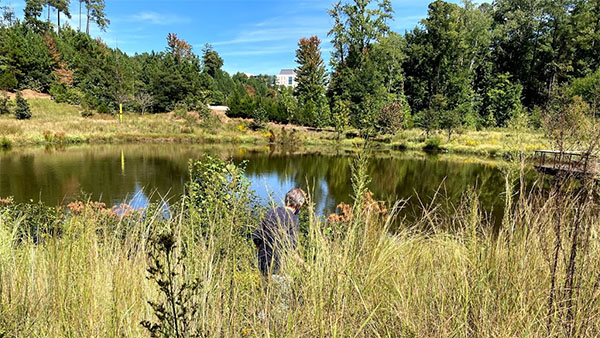
On Saturday, September 25, the Wild Ones club hosted an insect-themed outing with Fred Nijhout, an entomology professor at Duke. We visited a pond behind the Biological Sciences Building bordered by vegetation. Apparently, the long grasses and flowers are prime habitat for insects, which are often attracted to sunny areas and edge habitat. Along with several other students, I practiced “sweeping” for insects by swishing long nets through vegetation, a delightfully satisfying activity, especially on such a gorgeous fall day.

Professor Nijhout says much of his research focuses on butterflies and moths, but the insect biology class he teaches has a much broader focus. So does this outing. In just a couple hours, our group finds a wide array of species.

Many of the insects we see belong to the order Hemiptera, a group sometimes referred to as “true bugs” that includes more than 80,000 species. We find leafhoppers that jump out of our nets while we’re trying to look at them, a stilt-legged bug that moves much more gracefully on its long legs than I ever could on stilts, spittlebugs that encase themselves in foam as larvae and then metamorphose into jumping adults sometimes called froghoppers, and yet another Hemipteran with a wonderfully whimsical name (just kidding): the plant bug.
Professor Nijhout shows us a milkweed leaf teeming with aphids (also in the order Hemiptera) and ants. He explains that this is a common pairing. Aphids feed on the sap in leaf veins, which is nutrient-poor, so “they have special pumps in their guts that get rid of the water and the sugars” and concentrate the proteins. In the process, aphids secrete a sugary substance called honeydew, which attracts ants.
The honeydew excreted as a waste product by the aphids provides the ants with a valuable food source, but the relationship is mutualistic. The presence of the ants affords protection to the aphids. Symbiosis, however, isn’t the only means of avoiding predation. Some animals mimic toxic look-alikes to avoid being eaten. Our group finds brightly colored hoverflies, which resemble bees but are actually harmless flies, sipping nectar from flowers. Professor Nijhout also points out a brightly colored milkweed bug, which looks toxic because it is.
Image from Wikipedia user Alvesgaspar (GNU Free Documentation License, Creative Commons license).
Humans, too, can be fooled by things that look dangerous but aren’t. As it turns out, even some of our most basic ideas about risk avoidance—like not playing with bees or eating strange berries—are sometimes red herrings. When we pass clusters of vibrant purple berries on a beautyberry bush, Professor Nijhout tells us they’re edible. “They’re sweet,” he says encouragingly. (I wish I could agree. They’re irresistibly beautiful, but every time I’ve tasted them, I’ve found them too tart.) And on several occasions, to the endless fascination of the Wild Ones, he catches bees with his bare hands and offers them to nearby students. Male carpenter bees (which can be identified by the patch of yellow on their faces) have no stinger, and according to Professor Nijhout, their mandibles are too weak to penetrate human skin. It’s hard not to flinch at the thought of holding an angry bee, but there’s a certain thrill to it as well. When I cup my hands around one of them, I find the sensation thoroughly pleasant, rather like a fuzzy massage. The hard part is keeping them from escaping; it doesn’t take long for the bee to slip between my hands and fly away.


The next day, I noticed several bees feeding on a flowering bush on campus. Eager to test my newfound knowledge, I leaned closer. Even when I saw the telltale yellow faces of the males, I was initially hesitant. But as I kept watching, I felt more wonder than fear. For perhaps the first time, I noticed the way their buzzy, vibrating bodies go momentarily still while they poke their heads into blossoms in search of the sweet nectar inside. Their delicate wings, blurred by motion when they fly, almost shimmer in the sunlight while they feed.
Gently, I reached out and cupped a male bee in my hands, noticing the way his tiny legs skittered across my fingers and the soft caress of his gossamer wings against my skin. When I released him, his small body lifted into the air like a fuzzy UFO.
I realize this new stick-my-face-close-to-buzzing-bees pastime could backfire, so I don’t necessarily recommend it, especially if you have a bee allergy, but if you’re going to get face-to-face with a carpenter bee, you might at least want to check the color of its face.
If you could hold all the world’s insects in one hand and all the humans in the other, the insects would outweigh us. More than 900,000 species of insects have been discovered, and there may be millions more still unknown to science. Given their abundance and diversity, even the experts often encounter surprises.“Every year I see things I’ve never seen before,” Professor Nijhout told us. Next time you step outside, take a closer look at your six-legged company. You might be surprised by what you see.

By Sophie Cox, Class of 2025
